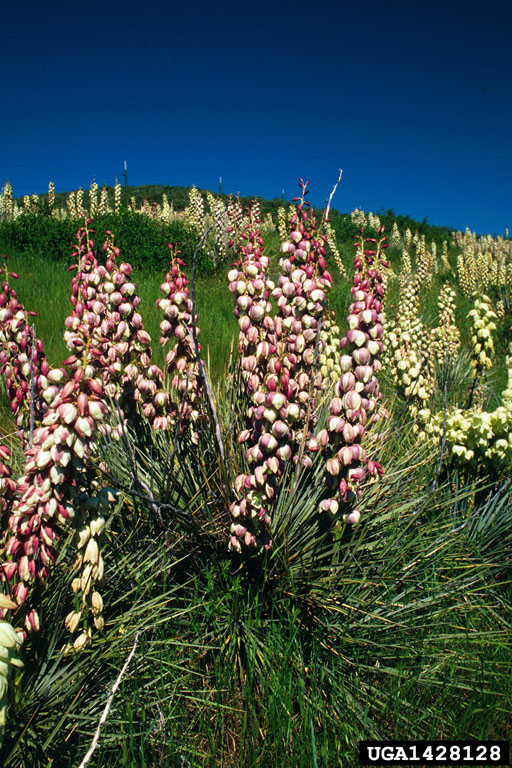 Yuccas - March 5, 2014 Jeff Schalau, Agent, Agriculture & Natural Resources University of Arizona Cooperative Extension, Yavapai County There are more than 40 species of yucca and all are new world natives. Several species are native to the southwestern United States. These range in size and shape from the multi-trunked Joshua Tree (Yucca brevifolia) with large, tall, branching stems (to 30 feet) and short leaves to the more compact yuccas that form two foot tall basal clumps (Y. arkansana). There are also several tropical species which have softer leaves and are more sensitive to frost. They have been (and occasionally, still are) harvested for food (flowers and fruits) fiber (leaves) and soap (roots). Sandals and mats made from yucca leaves by the Sinagua culture can be seen in many local archaeological displays. In times of drought on the range, yucca has been used as an emergency ration for livestock. Here, the stems were chopped and mixed with cottonseed meal to make a nutritious, palatable feed. Today, the roots are harvested for use in natural arthritis and rheumatism medicines. Yuccas produce showy, creamy white flower spikes between March and May. While closely related to Agaves, most Yuccas flower repeatedly, but a few are monocarpic (flower once, and then die) like most Agaves. All southwestern yucca species are pollinated by various species of small moths of the genus Tegeticula. When the yucca is in flower, male and female moths emerge and mate. The female moth collects pollen with her specialized mouthparts. She flies to another flower, lays her eggs in the flower ovary, and then climbs to the stigma and deposits the pollen. Yucca moth larvae hatch and feed on the maturing seeds. The larvae kill some seeds, but not all. Mature larvae drop to the ground, form cocoons, and pupate until the next flowering cycle. This symbiotic relationship facilitates reproductive success for both yucca and yucca Moth. Yuccas are both interesting and attractive when used in landscapes. They are very drought tolerant, long-lived, and come in several shapes and sizes. In the Verde Valley, there are at least two native varieties that are easily distinguished from each other. These are the Banana yucca (Y. baccata) with 1 1/2 to 2 inch wide leaves and Narrowleaf yucca (Y. angustissima) with 1/2 to 3/4 inch wide leaves. While these species are available from nurseries, several other species are also available and well suited for planting in our area. Before planting yuccas in landscapes, consider the size of the mature plant and amount of pedestrian traffic that will be in the area. Yuccas have sharp spines at the ends of the leaves that can easily pierce the skin and cause painful wounds. Of course, this can be used to advantage in landscapes by preventing access to private areas or discouraging illegal entry. The only serious pest of yucca I’m aware of is the Agave Snout Weevil. It is most damaging to the large Agave americana, but will also colonize yucca plants. An adult female enters the base of a plant to lay eggs. Decay microbes also enter through this injury and as the tissue rots, the plant develops a wilted appearance. Infested plants soon collapse and die. The larvae (grubs) develop in the dying plant, emerge, and may infect other suitable hosts nearby. Larger yuccas should be used as accent plants and smaller types work well in combination with cactus and succulents. All species listed below are adapted to our local climate, are highly drought tolerant, flower in spring, and prefer sandy, well-drained soil. Yuccas should never be grown in poorly drained, saturated soil. Narrowleaf yucca (Y. angustissima) grows 4 feet high by 1.5 feet wide and produces 1.5 foot flower spikes. Banana yucca (Y. baccata) grows 3 feet high by 3 feet wide and produces 2 foot flower spikes. Joshua Tree (Y. brevifolia) grows 4 feet high by 1.5 feet wide and produces 1.5 foot flower spikes. Soaptree yucca (Y. elata) grows 4 feet high by 1.5 feet wide and produces 3-4 foot flower spikes. Mohave yucca (Y. schidigera) grows 4 feet high by 1.5 feet wide and produces 2 foot flower spikes. This is not an exhaustive list, but you may be able to find some of these at local nurseries. Many are being propagated from seed by southwest growers. There are several yucca relatives that add similar interest and texture to residential landscapes. These include the genera: Agave, Hesperaloe, Hesperoyucca, Nolina, and Dasilyrion. Follow the Backyard Gardener on Twitter – use the link on the BYG website. If you have other gardening questions, call the Master Gardener help line in the Camp Verde office at 928-554-8999 Ext. 3 or e-mail us at verdevalleymg@gmail.com and be sure to include your name, address and phone number. Find past Backyard Gardener columns or provide feedback at the Backyard Gardener web site: http://cals.arizona.edu/yavapai/anr/hort/byg/. |